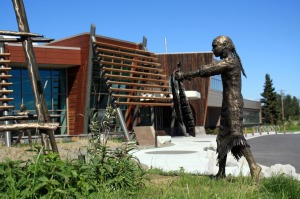
Photos by Patrice Kohl, for the Redoubt Reporter. A “Łuq’a Nagh Ghilghuzht” sculpture by Joel Isaak depicts traditional Dena’ina life at fish camp outside the Kenaitze Indian Tribe’s new Dena’ina Wellness Center in Old Town Kenai.
Clarification: It was incorrectly reported that the Dena’ina Wellness Center is currently seeing all veterans and is considering expanding medical services to the public. Currently, only Alaska Native and American Indian veterans receive VA services through the Dena’ina Wellness Center. As a community mental health center, behavioral health services are open to the public. Other services are available to Indian Health Service beneficiaries.
Through the joint venture award, Indian Health Service funding supports operation and maintenance for a minimum of 20 years. The state of Alaska Department of Commerce, Community, and Economic Development Division of Community and Regional Affairs provided $20 million to the project.
By Jenny Neyman
Redoubt Reporter
For the Kenaitze Indian Tribe, a new building in Old Town Kenai is an indication that the tide has turned.
A gradual erosion of culture, connection and community has reversed, and what was washed away, grain by grain, as if by the lapping pull of receding waves, is rushing back in, not only replacing what’s been lost, but reaching a new high-water mark.
That mark is a substantial one, both in its 52,000-square-foot physical form — the Dena’ina Wellness Center in Kenai — and in what it represents for the tribe.
“The Dena’ina word for it is ‘naqantughedul.’ For the tribe it means the tide is going out and it’s turning and going back in,” said Jaylene Peterson-Nyren, executive director. “It means the culture, the people, the land and just the lifestyle has been going away for many, many years, and it has taken a turn with this facility. It’s coming back.”
The building isn’t just a health clinic, nor was the motivation to construct it simply some tipping of an equation of funding and client base and service needs. It grew from a need to come together — to reconnect, strengthen and grow — and to improve health beyond just the physical.
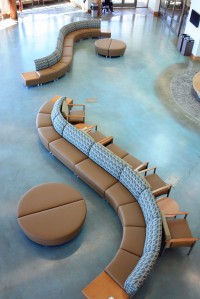
The lobby of the new, 52,000-square-foot Dena’Ina Wellness Center is meant to be an area for gathering and socializing, more than just a medical clinic reception lobby.
“We wanted to design not just a health clinic, but we wanted to look at wellness from a holistic perspective, and that means not just that you’d have your checkups and you check out well. It means social and economic wellness, it means educational wellness — knowledge. It encompasses relationships across the board with customers who come in to seek services and for staff who are all working together on behalf of our customers,” Peterson-Nyren said.
Fittingly, then, the facility consolidates the tribe’s three health services programs under one roof — medical, dental and behavioral — as well as expands new services to address the wellness of a person as a whole, not just whether they’re running a fever.
“We try to focus on prevention and intervention. We want to encourage people to return. That’s one of the reasons we built the Gathering Space (building entrance room) is we want people to want to be here,” she said.
Along with being a center for holistic wellness, the brand-new facility, with construction starting in August 2012 and the grand opening ceremony June 12, is also a hub of social connection — an area of wellness which the tribe believes also needs care.
It’s designed to facilitate both — new equipment and the latest technology to aid the delivery of quality medical services, and a welcoming, calming, comfortable design to encourage people to come and enjoy the facility. The entry leads into the Gathering Space, with a large, open, airy design and windows stretching floor to the second-story ceiling above. A stage area anchors the wall facing the doors, while a reception desk, curved as if beckoning a visitor further into the building, stands to the right of the stage. To the left of the entrance is a wide staircase giving the feel of floating upward as it parallels the windows looking out over Old Town toward the mouth of the Kenai River and Cook Inlet. Upstairs are balcony railings to allow a bird’s-eye view of the stage and circular Oculus feature below, which will have a commissioned art piece suspended above it.
The whole space can be configured for large gatherings, such as the grand opening of the facility, which was packed to standing room only. Over 1,000 people came through the facility during the two days of tours, presentations and festivities, Peterson-Nyren said.
“I think the response has been tremendous,” she said. “It was amazing to feel that community support, just everyone showed up.”
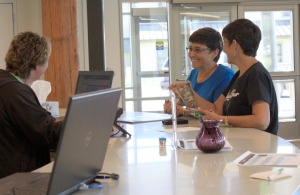
Karen Tollackson, left back, and Sharon Isaak, front right, chat at the center’s reception desk as Isaak explains how she made a birch-bark basket she recently completed in a wellness activity arts and crafts class held at the center.
And that has continued to be the case. Peterson-Nyren said she was delighted on a recent visit to see a multigenerational group catching up, tucked away in a nook under the stairs in the Gathering Space.
“It turns out the young man was a nephew that the two women shared in common. They hadn’t seen each other in years. In our old (medical clinic) location you were in a tiny space and people just crammed in, not in a sense that you wanted to sit and visit. Well here people can spread out and catch up with people. That social interaction is so important,” she said.
The exterior architecture of the earth-toned building is garnished with two-story-high slanted vertical wooden frames crossed by horizontal wood slats, mimicking the design of traditional Kenaitze fish-drying racks. Bronze statues outside, by Joel Isaak, of Soldotna, also depict traditional fishing activity.
They are, after all, the Kahtnuht’ana Dena’ina people, meaning the river mouth people (Kenaitze comes from the Russian pronunciation of the tribe’s traditional name). They are the only Athabascan tribe to live on the ocean and a river, Peterson-Nyren said. It was important to reflect the tribe’s unique heritage and homeland in the design of the building.
“We wanted to evoke Dena’ina culture. We wanted to get the color and design of the facility right. We want to make sure we encompass all of that,” she said.
The colors in the ground-level entry area evoke the river and ocean — in a blue tinge to the polished-concrete floors, and the agates, gathered by tribal members from Cook Inlet beaches, inset in the flooring. They progress to forest colors in the exam rooms on the first floor and shift to mountain hues upstairs in the dental area.
And other touches of cultural heritage are imprinted, or will be, throughout the building, including hallway display cases that will hold Dena’ina artifacts, the tile pattern in the restroom inspired by Dena’ina bead patterns, wood from the 100-year-old Libby, McNeill and Libby cannery warehouse across the river used in the floors and trim throughout the building, and all the artwork yet to be chosen and displayed on the walls. One touch already in place is the signs identifying all the rooms. Each has the English description of the room, with the description in Braille underneath, the word in Dena’ina and a literal translation in English under that. Electrical, for instance, is “hot rope house.” The men’s and women’s locker rooms are “where men/women keep things.” Imaging is “photograph place.” And the endoscopy and treatment room, probably most gigglingly apropos, is “one looks inside place.”
As difficult as it was to make all the design decisions, Peterson-Nyren is proud of how the facility has turned out. The process was a little different for such a large-scale project. Instead of deciding things as construction progresses — paint colors, carpeting, window dressings, etc. — they made a concerted effort to think through the entire space beforehand and make as many decisions as possible up front.
“Before the architects really put pen to paper they interviewed all of our elders. They worked with all of our staff, they spent time at length with all of our council members,” Peterson-Nyren said. “It was so intentional. Every square inch was intended in this building as multipurpose, but focused use for wellness.”
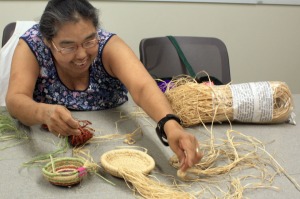
Rose Guilbeau, of Kenai, displays several baskets she has begun working on while attending one of the center’s arts and crafts classes Monday.
That shows in the function of the facility, as well. There are large examples, such as having classrooms that can hold group diabetes nutrition sessions, financial literacy classes, arts and crafts workshops and other educational programs, an exercise room, a meditation/yoga room and a demonstration kitchen to share healthy cooking.
And there are other examples clients might never notice — videoconferencing technology — so those healthy food prep sessions could be turned into Cooking Channel-type shows, for example — an efficient workflow for sanitizing equipment in the dental area, and the lack of private offices for staff. Care providers spend most of their time with patients as it is, and having a more communal,
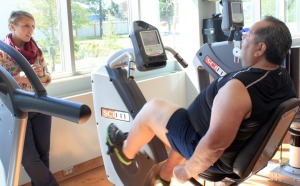
Exercise physiologist and tobacco program coordinator Amber Delago-Harrison advises Eric Morrison in the activity room as he pedals on a stationary bike.
cubical approach to office space encourages interaction. Instead of having to drive or call across town to consult with a colleague, staff can now just pop their head over a partition or flag someone down as they’re leaving the break room.
“This is a unique design that is intended for providing care in an integrated way. Everybody works together,” Peterson-Nyren said.
Karen Pulley, a dental hygienist, said she enjoys the closer quarters of the integrated work spaces, especially in being able to work closely with other staff.
“It’s nice to be in a group where you don’t have to drive across town to confer or try to catch somebody on the phone,” she said.
The entire building is specifically designed with input from staff to function well for the service it’s meant to provide, rather than being generic offices modified into clinic space. In the dental area, this means interconnected pods of three exam rooms per dentist, one being private and two open, with a dental hygienist assigned to each pod. X-ray equipment can be swung from one open pod to the other through the dividing cabinetry, so equipment can be shared. Each pod has a computer kiosk for writing prescriptions or exam notes, so the office functions paperlessly.
“This is just heaven for the doctors to have this much space. And we’re really proud of our lab. We came out of a closet, literally. So this is just really fabulous,” said Karen Pulley, a dental hygienist.
Prior to moving into the new facility, the tribe’s health services were spread out in several locations in town. The dental, behavioral and medical clinics were in separate, leased offices. They were cramped, in nonideal locations, functioned poorly and were out of room to expand.
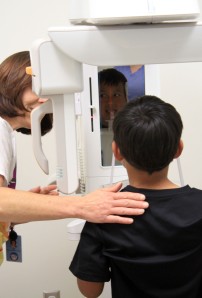
Dena’ina Wellness Center dental assistant Kris Smith prepares Lucas Oyoumick for a dental x-ray in the center’s dental clinic.
“We had run out of leasable space, and a strip mall is not suitable for the kinds of programs and activities that we really needed to operate,” Peterson-Nyren said.
“We made that small space work but now it’s like we’re living in a mansion in the sky, with windows!” Pulley said. “We’re really excited and feel very blessed to be part of it. It’s great to come to work every day to a nice facility. It’s so well thought out that everything flows for us.”
That intentional approach is applied to meeting the needs of clients, as well, Peterson-Nyren said, particularly with the emphasis on preventative care. In the dental area, for example, a youth oral hygiene program where participants enter drawings for movie tickets has proven successful.
“The numbers do not lie. They’re meeting and exceeding the measures for a healthy population in dental,” Peterson-Nyren said.
And staff makes a big effort to make visits as comfortable and nonthreatening as possible. Parents are invited to bring their young kids to their appointments, to start getting them familiar with the setting.
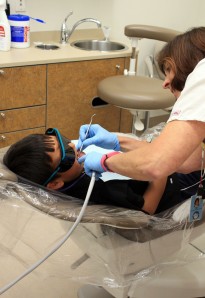
Jonas Oyounmick opens wide as dental assistant Karen Smith counts his teeth in the center’s dental clinic.
“To see us performing and putting on our costumes so they’re not as afraid when it is actually their turn in the chair. And we don’t push them, we’ll reschedule for when they’re ready to come back because we don’t want to create any fear. We’re hoping to have a whole new generation without any dental fears,” Pulley said.
While the facility keeps the next generation in mind, it was the previous one driving the push for the wellness center.
“Our elders, it’s been their priority for probably 40 years now to have a health care facility. We’ve always been underserved, but when you go back 30 or 40 years people were walking to Seward to see the doctor there to get a tooth pulled or a tooth filled. Government ships would pull up and come into the classroom and everybody had a tonsillectomy at once, sitting in their chair with a spoon. That was health care,” Peterson-Nyren said.
Elders would hold garage sales to pay for heath services for tribal members. The original dental clinic 20 years ago was so cold the dentist would have to hand crank the dental equipment to get it going. The stories go on and on.
“It has been a struggle and such a need for so long. This has been an alignment of need and resource, excellent staff and stable leadership, and I am just happy to be here in this moment to assist the tribe in pulling it all together. It has been an incredible process and project,” Peterson-Nyren said.
The tribe obtained a 20-year commitment for operational funding in the highly competitive Indian Health Service Joint Venture Award in fiscal year 2011, one of only three projects nationwide to do so, as well as $20 million from the state of Alaska. Cook Inlet Region Inc. the M.J. Murdock Charitable Trust, the Rasmuson Foundation and Alaska Mental Health Trust kicked in funding, as well. The tribe also contributed, slowly purchasing land to have a place for the facility.
The center serves Kenaitze and other Alaska Native and American Indian people, and can serve veterans who are also Natives. Programs receiving state funding — behavioral health and the chemical dependency program — are open to the community. Programs might expand in the future, but the center is focusing on getting settled in the new space first, Peterson-Nyren said. The center is in the process of hiring for 50 new positions created with the new center, which in the future might include an optometrist, and perhaps monthly visits from a regional orthodontist.
“We’re trying to pace ourselves in adding services, especially doctors. We want to be intentional about it,” she said, Peterson-Nyren said.
After all, the tribe is building a whole new facet and phase of its existence with the wellness center, even though it is built upon a literal and figurative old foundation.
“The tribe has had over the course of the past 20 years just really painstakingly saved every dime and purchased back what used to be their property. A lot of that was lost with the World War and other people moving in, and there was some tragedy there that I think we can set aside now and really have a sense of renewal in this place. The elders who are visiting, they all grew up here, this was their village. The trail that goes down by Veronica’s, that was their sledding hill. They all lived here. Only in the last probably 30 or 40 years has it kind of dissipated. So it’s really important that we’re back here in this place,” she said.

